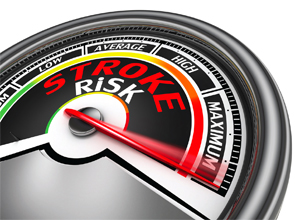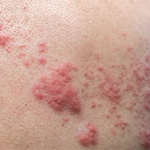
Image Credit: donskarpo/shutterstock.com
SAN FRANCISCO—The risk of stroke after herpes zoster (HZ) infection is elevated in the period immediately after infection in patients with autoimmune diseases, according to a study presented at the 2015 ACR/ARHP Annual Meeting.1
The findings were presented in a scientific session, called Discover 2015, that highlighted new research. In another study from the session, researchers reported findings showing that intra-articular corticosteroids are safe and have no major effect on structural progression of synovitic knee osteoarthritis (OA).2
Increased Stroke Risk

Dr. Calabrese
In the herpes zoster study, researchers from the Cleveland Clinic looked at Medicare data from 2006 through 2013, pulling data on patients with rheumatoid arthritis, inflammatory bowel disease, psoriatic arthritis, psoriasis and ankylosing spondylitis, said Leonard Calabrese, DO, head of the clinic’s Section of Clinical Immunology. To be included, subjects must not have had a previous stroke or a previous diagnosis of HZ or have taken an antiviral drug.
Researchers tracked patients after an HZ diagnosis, and the main outcome was hospitalized stroke.
For all types of HZ, incidence of stroke was higher in the period right after the diagnosis, with 1.4 hospitalized strokes per 100 patient-years up to 30 days after diagnosis, and 1.2 in the second and third months after diagnosis. The stroke incidence continued to trail off after that.
Among those with serious or complicated HZ types—such as HZ of the cranial nerve or herpes zoster ophthalmicus—the difference was even more striking. The incidence within the first 30 days of diagnosis was 3.3 per 100 patient-years, and 1.8 in the second and third months, after which the incidence fell off.
The same pattern with respect to stroke and time from HZ diagnosis held true after adjustment for age, sex, diabetes, hypertension, atrial fibrillation, transient ischemic attack and glucocorticoid use.
Researchers found the incidence rate was higher among those who had not received anti-viral therapy within seven days of their HZ diagnosis. This was consistent with another publication, Dr. Calabrese said.3
“Immunosuppressed patients appear to be at an increased risk of stroke immediately after zoster, particularly in the first 30 days,” Dr. Calabrese said. He also said the data suggest that patients with immune-mediated diseases are under-protected because of a low rate of vaccination.
“They may be missing an additional downstream benefit of vaccination—subsequent reduction in stroke,” he said. “Collectively, on the basis of these data, we think that new strategies to optimize [the] prompt diagnosis and treatment [of], as well as preventive measures for, zoster are urgently needed.”
Intra-articular Corticosteroids & Knee OA
In the osteoarthritis study, researchers found no major effect of intra-articular corticosteroids on structural progress in knee OA patients. The therapy is widely used for knee pain in OA, but there is concern that it could accelerate damage to the knee. These findings might help ease those concerns.
The therapy has previously been found to be safe in the long term, but new technology—MRI, dual X-ray absorptiometry (DXA) and ultrasound—“offers [the] potential to scrutinize more carefully [the] structural effects of interventions,” said Timothy McAlindon, MD, MPH, chief of rheumatology at Tufts University.4
Intra-articular triamcinolone 40 mg every three months over two years into knees with synovitis has no major effect on structural measures either deleterious or beneficial. —Dr. McAlindon
Researchers randomized 140 knee OA patients—70 in each group—to receive injections of 40 mg of triamcinolone or saline every three months. Patients had to be at least 45 years old, with chronic knee pain and a WOMAC LK 3.1 pain subscore of at least 2.
Patients’ symptoms and self-reported function were assessed at each visit, with objective physical function tests given every six months. MRI and DXA imaging were done at 12 months and 24 months.
Researchers did find some difference in the cartilage damage index (CDI), with a drop in CDI of 0.84% in the saline group and a drop of 2.86% in the triamcinolone group. There was a drop in mean cartilage thickness of 0.57% in the saline group and of 1.7% in the triamcinolone group.

Dr. McAlindon
Dr. McAlindon noted that the difference, although significant in statistical terms, was not large.
“The relative differences are quite similar—about 1% difference in change between the two groups,” he said.
There were no statistical differences in the secondary outcomes of denudation, bone mineral loss, effusion volume and bone volume fraction.
“Intra-articular triamcinolone 40 mg every three months over two years into knees with synovitis has no major effect on structural measures either deleterious or beneficial. In particular, we found no evidence of accelerated progression,” Dr. McAlindon said. “Also, we found no influence on patient-reported outcomes or objective physical function tests over the long term.”
Thomas R. Collins is a medical writer based in Florida.
Second Chance
If you missed this session, it’s not too late. Catch it on SessionSelect
http://acrannualmeeting.org/resources/sessionselect
References
- Calabrese L, Xie F, Yun H, et al. Herpes zoster and the short term risk for ischemic stroke in patients with autoimmune diseases. Presented at the 2015 American College of Rheumatology/Association of Rheumatology Health Professionals Annual Meeting. Nov. 6–11, 2015. Abstract 896.
- Driban J, Lavalley M, Price L, et al. Intra-articular corticosteroids are safe and have no major effect on structural progression of synovitic knee OA: A 2-year randomized controlled trial of 3-monthly triamcinolone hexacetonide. Presented at the 2015 American College of Rheumatology/Association of Rheumatology Health Professionals Annual Meeting. Nov. 6–11, 2015. Abstract 897.
- Lin HC, Chien CW, Ho JD, et al. Herpes zoster ophthalmicus and the risk of stroke: A population-based follow-up study. Neurology. 2010 Mar 9;74(10):792–797.
- Raynauld JP, Buckland-Wright C, Ward R, et al. Safety and efficacy of long-term intraarticular steroid injections in osteoarthritis of the knee: A randomized, double-blind, placebo-controlled trial. Arthritis Rheum. 2003 Feb;48(2):370–377.
